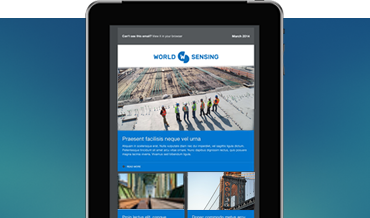Tunnel monitoring: cost-effective monitoring in hydrological projects
Our planet is in turmoil. The climate is shifting, changing weather patterns, and creating new critical infrastructure challenges. Whereas civil engineering and construction projects have traditionally been concerned with developing new structures, increasingly now they are being carried out to cope with changes in the environment.
That’s the case, for example, with hydrological tunnels—civil engineering projects designed to channel rainwater and wastewater into treatment facilities where the water can be cleaned before going into the environment. Around 700 cities worldwide have combined sewer systems for this, but with changing weather patterns there is often a growing need to build new large-scale deep tunnels to cater to storm surges and similar events.
“In many of our older cities today, current sewer systems cannot handle the massive amount of water that comes in when we have heavy rainfall,” explained Worldsensing Sales Manager Kelsey Kidd in a recent webinar.
The flooding of combined sewer systems can represent a major health hazard, so “these cities are looking at upgrading infrastructure programs designed to capture and clean our wastewater,” Kidd added.
Hydrological tunnel monitoring
Tunnel monitoring is particularly important for these projects because many of them involve digging massive tunnels under built-up areas. One example is the Northeast Boundary Tunnel, or NEBT, which was designed to connect sewer systems in Washington DC. This tunnel had a diameter of 23 feet and ran for five miles under the US capital.
The tunnel monitoring service provider on the project, EnTech Engineering, used a Worldsensing wireless data acquisition system, supplied by Specto Technology, to connect sensors in 280 locations around the NEBT. Tyree Williams, Sales Manager at Specto Technology, said the LoRa technology used by Worldsensing was ideal for this kind of project because it allowed for quick and easy installation even within built-up neighborhoods.
Also, “everything with Worldsensing is almost plug and play,” he said. “Worldsensing is reliable, it’s quick, and for that reason, you’re able to cut back on a lot of costs.”
Hydrological tunnels: your questions answered
How does LoRa compare to direct-to-satellite IoT?
Tamara Maxwell, Technical Sales Specialist at Worldsensing: I believe they could actually be used as complementary technologies, for example, if the area you are covering does not have options for a local area or cellular network. You could use LoRa to send remote sensor data to the gateway, but then if the gateway needs to communicate with the internet the ideal solution would be a satellite modem.
How have you convinced budget-conscious customers to adopt a sustainable monitoring approach?
Kelsey Kidd: This is a budget-conscious choice. We’ve worked with clients who are using manual monitoring, which is still very common. And we’ve been able to save them at least 50%. It’s obvious almost immediately that there are going to be cost savings moving in this direction.
How open or accessible is this technology?
Tamara Maxwell: The data loggers can be easily scaled to your system. This means if you want to make changes in your system, you don’t have to have Worldsensing come back and reprogram it. So if you want to add a new sensor, you can just go ahead and pick up the new data logger, connect it to your gateway in your existing system, you’re good to go.
In addition, all these data loggers can be opened, therefore you can easily change batteries if you need. The last thing is that our software is very open. We have a connectivity management tool, and we pride ourselves on being able to work with the different technologies that our clients have already implemented, so there’s no change to your system.
What is the maximum horizontal and depth range coverage of these sensors?
Tamara Maxwell: We can look at the coverage in two ways. The first is the distance inside the tunnel to the gateway. In this case, we had good signal coverage up to 4 kilometers for a linear tunnel. This coverage will, however, be dependent on the geometry of the tunnel. For example, the curvature and change of grade may reduce that coverage. The second way we can look into this is by depth.
For the gateways that are located underground, it will be important to have a power source and internet connection to ensure data can be remotely streamed. We can also look into sensors that will be placed outside the tunnel, either on the surface or in-ground, to monitor the surrounding environment.
The coverage can vary here as well, based on if these sensors have a line of sight, need to pass through obstructions, or are placed inside a manhole. All these sensors communicate with a gateway placed on the surface, for example on the top of a building, and have the option to stream data via a SIM card on a cellular network.
